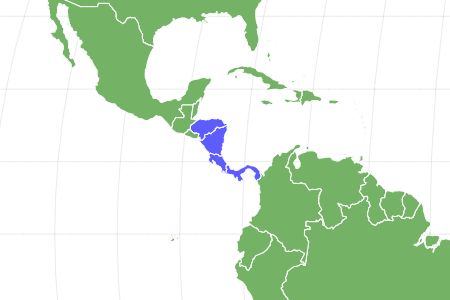Honduran White Bat
Ectophylla alba
The bat only eats figs.
Advertisement
Honduran White Bat Scientific Classification
- Kingdom
- Animalia
- Phylum
- Chordata
- Class
- Mammalia
- Order
- Chiroptera
- Family
- Phyllostomidae
- Genus
- Ectophylla
- Scientific Name
- Ectophylla alba
Read our Complete Guide to Classification of Animals.
Honduran White Bat Conservation Status
Honduran White Bat Facts
- Name Of Young
- Pup
- Group Behavior
- Colony
- Fun Fact
- The bat only eats figs.
- Estimated Population Size
- Unknown, but declining
- Biggest Threat
- Habitat loss
- Most Distinctive Feature
- Its all white fur
- Other Name(s)
- Caribbean white tent-making bat
- Gestation Period
- Three weeks
- Litter Size
- One
- Diet
- Omnivore
- Favorite Food
- Figs
- Type
- Mammal
- Common Name
- White bat
- Location
- Central America
Honduran White Bat Physical Characteristics
- Color
- Yellow
- White
- Skin Type
- Fur
- Top Speed
- 20 mph
- Lifespan
- Unknown, but related species have been known to live between seven and 18 years in nature.
- Weight
- .20 ounces
- Length
- 1.46 to 1.85 inches, with 4-inch wingspan
- Age of Sexual Maturity
- 35 days
- Age of Weaning
- 20 days
View all of the Honduran White Bat images!
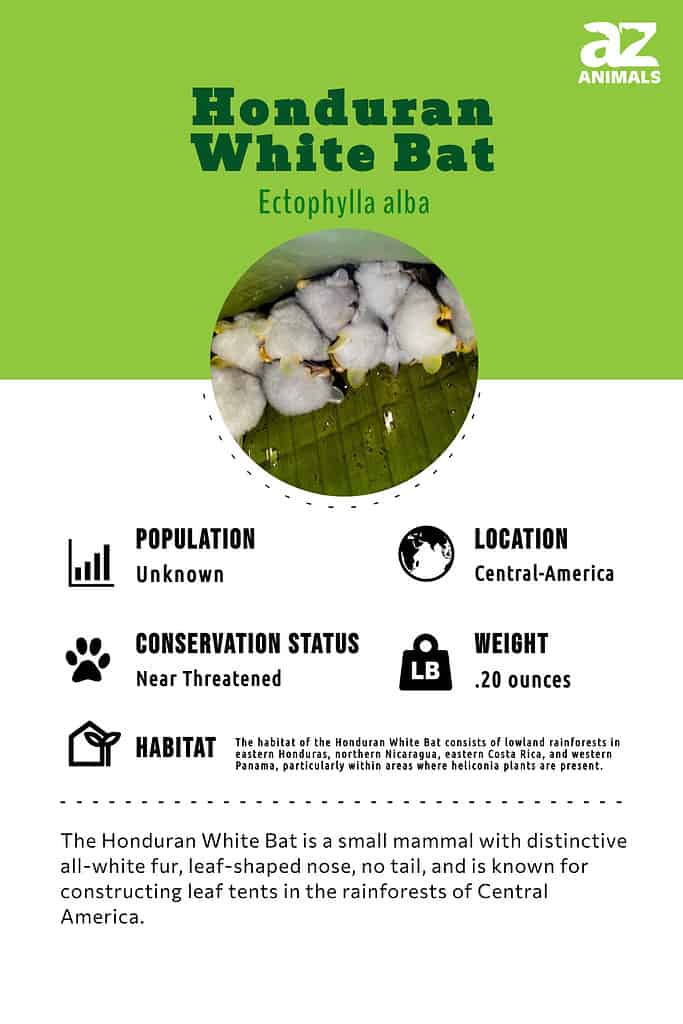
The Honduran white bat makes little “tents” out of the leaves of the heliconia plant, then rests in them during the day.
They make sure they build their nests a short distance from a particular type of fig tree, for the bat only eats the fruit of this tree. Once the tent is built, it can hold up to 15 of the tiny bats.
Males visit female roosts to mate, but other than this, adult males and females live separately.
5 Incredible Honduran White Bat Facts!

The Honduran bat is one of a handful of bats whose fur is completely white.
©Milan Zygmunt/Shutterstock.com
- The Honduran bat is one of a handful of bats whose fur is completely white.
- It creates tents by biting through the ribs of tree leaves.
- It only eats the fruit of one type of fig tree.
- It has a yellow nose, lips, and ears because carotenoids, the pigments that give carrots their orange color, are deposited in these areas of the bat’s body.
- It has a nose shaped like a leaf. Some scientists believe this helps the bat in echolocation. Since it flies at night and its eyesight isn’t too good, echolocation helps the bat find food.
Scientific name
The scientific name of the Honduran white bat is Ectophylla alba. It is the only species in its genus Ectophylla, which means “out-leaf” in Greek. This describes the animal’s nose. Alba is derived from the Latin word “albus” and means ”white.” This describes the bat’s fur.
Evolution and Origins
The Honduran white bat can be found across various Central American countries, such as Costa Rica, Honduras, Nicaragua, and Panama.
Interestingly, it is one of only four species of leaf-nosed bats exclusive to Central America, while the majority of similar bats are typically found in South America.
The habitat of Honduran white bats is limited to the lowland rainforests of eastern Honduras, northern Nicaragua, eastern Costa Rica, and western Panama.
These bats specifically reside in rainforest areas characterized by the presence of heliconia plants.
Appearance
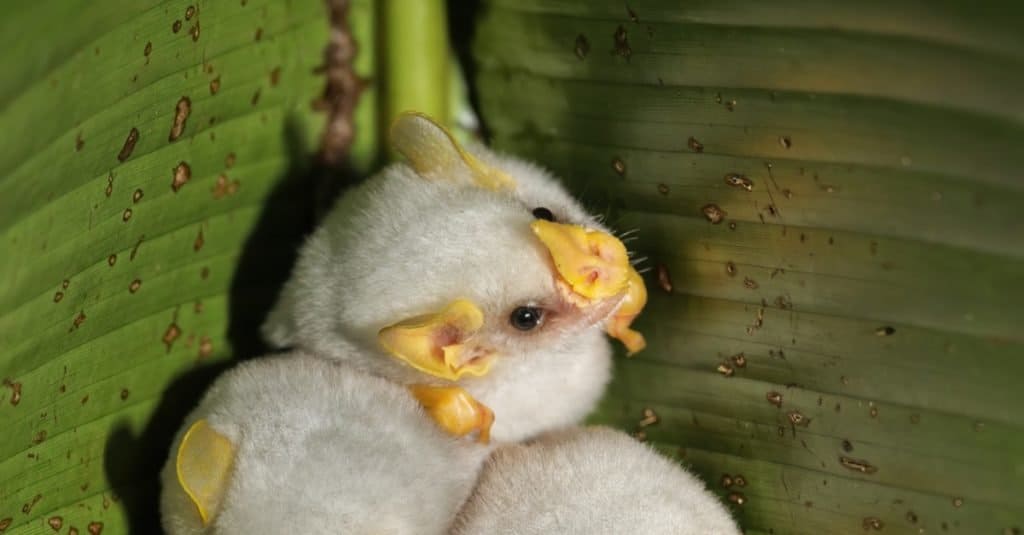
This small bat is characterized by its pure white fur and a nose that resembles a leaf. It lacks a tail and typically measures between 1.46 to 1.85 inches in length, with a wingspan of approximately 4 inches.
©Don Mammoser/Shutterstock.com
This little bat is distinguished by its all-white fur and leaf-shaped nose. It has no tail, and it ranges from 1.46 to 1.85 inches in length, with a wingspan of about 4 inches. Its ears are large and round and serrated around the edges, with four to five tiny lobes.
The edge of the nose is also saw-toothed, and it has what appears to be tiny warts beneath its mouth. Males are believed to be slightly larger than females. The bat’s weight is about .20 ounces, and it has 28 teeth.
Behavior
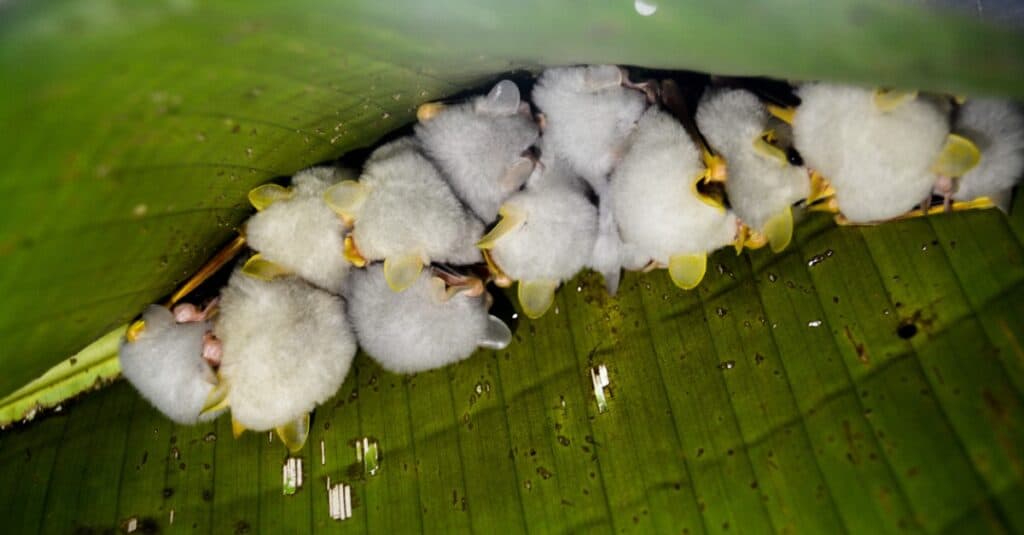
One of the most intriguing behaviors exhibited by this diminutive mammal is its ability to build leaf shelters.
©iStock.com/Robi_J
One of the most fascinating things this small, flying mammal does is construct leaf tents. They make them mostly out of the leaves of heliconias, a large tropical flowering plant. The bat uses its teeth to cut out the side veins that grow out of the rib of the plant’s large leaves. This causes them to fold over and form a tent.
It takes some weeks to build tents. The bat needs to build them again and again, for shaping the leaf this way greatly shortens the leaf’s normal lifespan. Females have been seen making tents, and they sometimes build them together. Scientists assume that males build tents as well.
The bat prefers younger leaves because they are easier to manipulate and bite through. An ideal leaf is less than 6.6 feet above the ground, and between 2.6 and 3.9 feet long. The bat also prefers their tent to be in an area where there aren’t too many plants in the understory but a high density of plants in the upper canopy.
The former makes it easier for the bat to leave the tent, and the latter protects the tent and its occupants from the weather. Bats build a series of tents and alternate between them. It prefers to build tents next to its food source, a fig tree.
A Honduran white bat is very hard to see in its tent because a trick of the sunlight turns their fur the same green color as the leaf. Scientists also believe that the sight of the white fur mimics a wasps’ nest, and this deters predators.
Tents usually hold five female bats and one male who mates with all of them before he flies off to a bachelor colony. A larger tent can hold as many as 15 bats.
Habitat
The bat’s preferred habitat is the wet tropical forests found in Costa Rica, Nicaragua, Panama, and Honduras. It is found between sea level and 2297 feet above sea level. A bat’s home range is about 63.2 hectares, though the animal isn’t territorial and won’t fight for the right to own a particular tent. The tropical rainforests of Central America are ideal because the warm and humid climate allows the figs the bat eats to be available all year.
Diet
The Honduran white bat specializes in figs, especially the fruit of the Ficus colubrinae tree. If it can’t find fruit on this type of fig, it will use other fig trees such as Ficus schippii. F. colubrinae is able to produce a lot of fruit and produce it year-round, but scientists aren’t quite sure how the bat can stay healthy on such a limited diet.
Predators and Threats
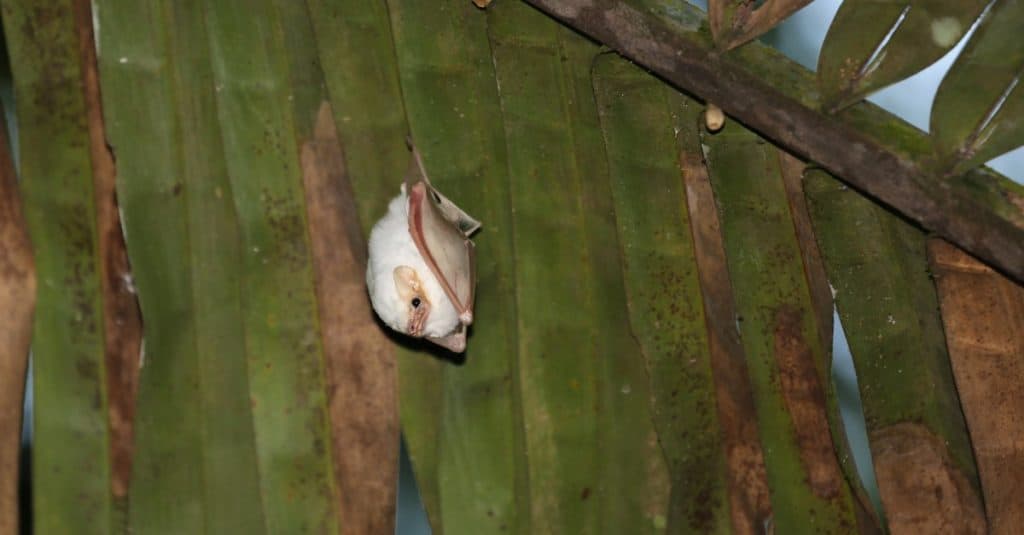
The Honduran white bat is classified as a “recent” species as it was initially identified in 1892, and subsequently rediscovered in 1963.
©Uwe Bergwitz/Shutterstock.com
The Honduran white bat is considered a “new” species because it was only discovered in 1892, then discovered all over again in 1963. As of 2021, its population is in decline, largely because of habitat destruction as the forests where it lives are converted into farmland and suburbs. The Honduran white bat’s conservation status is considered near-threatened.
The bat’s predators are carnivores that can find and reach their roosts, either by flying or climbing. These include owls and other birds of prey, snakes, and monkeys including squirrel monkeys and capuchin monkeys.
The Honduran white bat does not seem to be subject to parasites or diseases that attack them specifically. Their tents protect them from rain, wind, and the heat of the sun. Mortality seems to come largely from predation.
Reproduction and Life Cycle
The Honduran white bat breeds during the warmer, wetter months in Central America. Females release pheromones to signal their readiness to mate.
One male mate with the females in a roost and then returns to his bachelor colony when they give birth. All the females in the roost give birth around the same time. After about three weeks of pregnancy, each female has one baby or pup.
A baby bat can weigh a third of the mother’s weight when they’re born, yet they cling to her body until they are simply too heavy to carry. When this happens and the mother must leave the roost to look for food, the other females will take care of her baby and even nurse it.
Pups are weaned and flying at 20 days. They are completely independent when they are 35 days old and can scarcely be told by an adult.
Though scientists aren’t sure how long Honduran white bats live in the wild, a similar species can live as long as 19.5 years while in captivity.
Population
The population of the Honduran white bat is unknown, but it is understood that its population is in decline because of habitat loss.
View all 104 animals that start with HHonduran White Bat FAQs (Frequently Asked Questions)
Are Honduran white bats carnivores, herbivores or omnivores?
The Honduran white bat is distinctive because it is none of those things. It is a frugivore, which means it only eats fruit. In this case, it only eats the fruit of a certain fig tree found in Central America.
What is a Honduran white bat?
A Honduran white bat is a type of bat found in Central America. A bat is the only mammal that is capable of truly flying, and its hands and forelimbs have evolved into leathery wings. The Honduran white bat is notable for its all-white fur. It is one of only six bat species that have all-white fur, and there are about 1300 bat species. It’s also famous for making tents out of heliconia leaves.
Can you have a Honduran white bat as a pet?
Besides the legality of actually owning a Honduran white bat, it would be very difficult to keep one happy and healthy in captivity. The owner would need to replicate the temperature and humidity of the bat’s rainforest home very closely and make sure the animal had a steady diet of figs from the F. colubrinae tree. It also will need lots of room to fly. It’s unlikely a white bat would live a long, healthy life as a household pet.
Are there any white bats in Honduras?
There is still a population of white bats in Honduras.
Are white bats dangerous?
Honduran white bats are not dangerous. Biologists who have handled them have described them as timid and sweet-natured. The chance of a Honduran white bat being rabid are quite small. They are far more endangered than dangerous.
Are Honduran white bats endangered?
Honduran white bats are not considered endangered, but their status is near threatened because the forests where they live are being destroyed. Their situation is also precarious because they depend so utterly on the fruit of only one type of tree.
Thank you for reading! Have some feedback for us? Contact the AZ Animals editorial team.
Sources
- Bat Conservation International / Accessed April 3, 2021
- Wikipedia / Accessed April 3, 2021
- Animal Diversity Web / Accessed April 3, 2021
- Smithsonian Magazine / Accessed April 3, 2021

